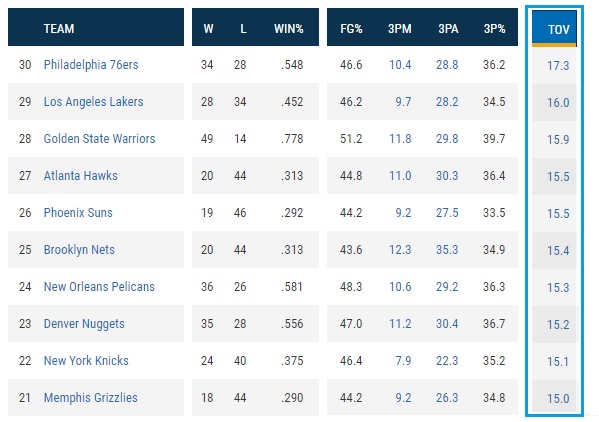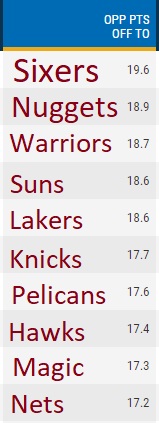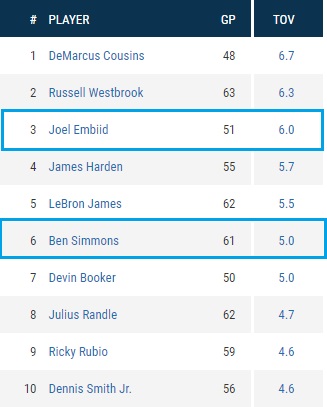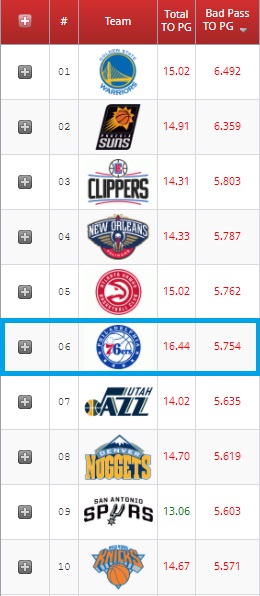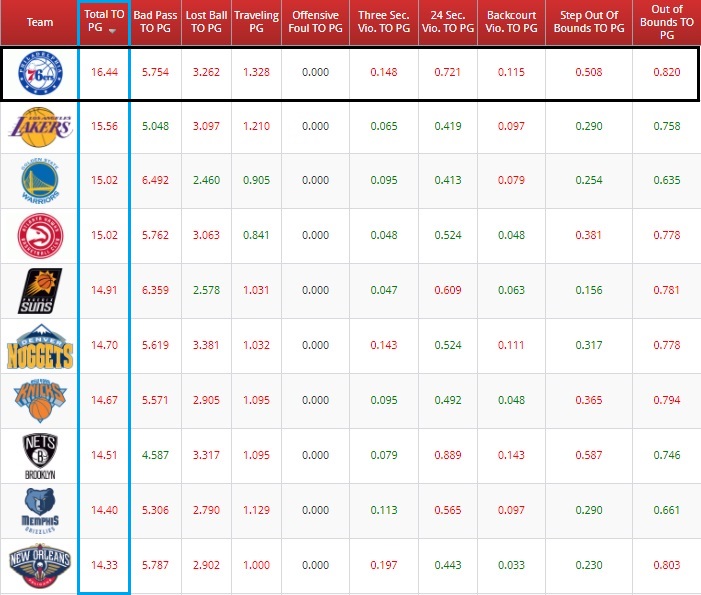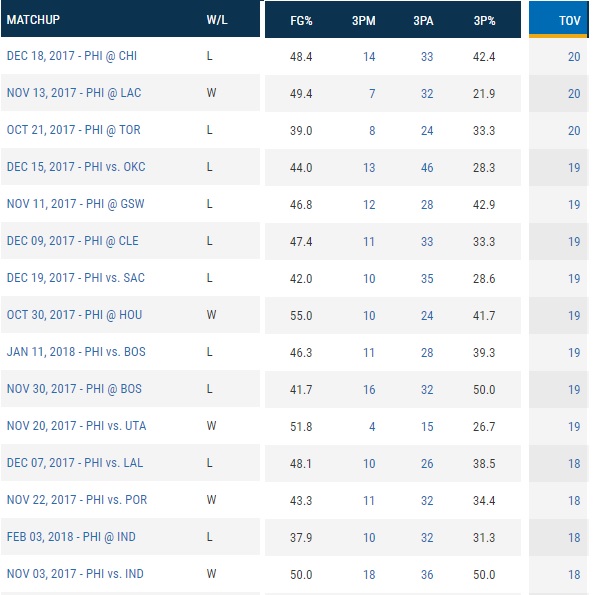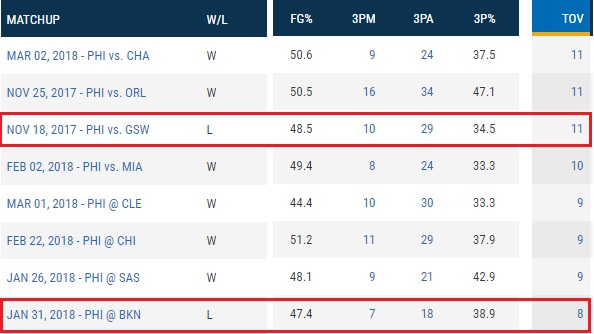Ad Disclosure
The 76ers and Turnovers
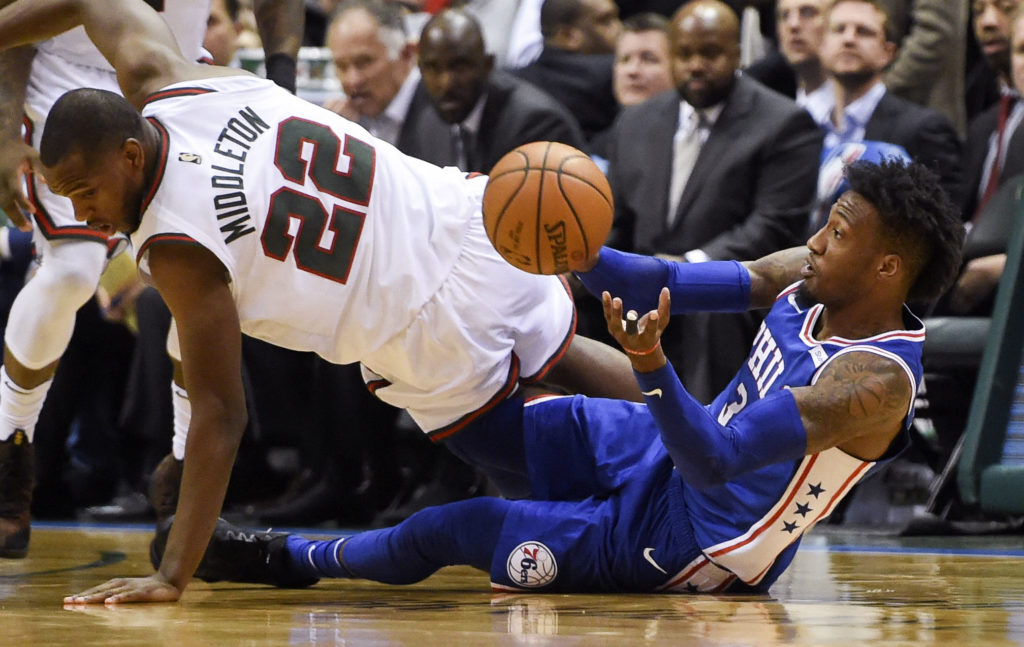
Another Sixers loss, more bitching about turnovers.
It’s warranted, of course. They were all over the place last night, throwing the ball away, losing the handle, traveling, and stepping out of bounds. They hit a season-high of 26 in the wretched collapse.
It was slop, and it was the main reason for the loss, though they also got killed on the glass and couldn’t hit a third-quarter shot to save their lives, but that stuff gets lost in the shuffle when the “fire Brett Brown” crowd comes crawling out of the woodwork. Nevermind the fact that the Sixers are 9-3 in their last twelve games.
I don’t do a ton of hot takes, but we’ve been down this road with the turnovers before. What we’re going to do for this exercise is first dive into a bunch of turnover-related statistics and see what we can find, then we’ll make a conclusive statement at the end of the article.
League-wide numbers
Believe it or not, the Sixers’ turnover numbers are down in total from the middle of November, when they were giving it up more than 18.5 times per game.
They’re still, however, worst in the league:
Of the ten-worst turnover teams, four have a winning record and six have a losing record. That first grouping includes the current 6th seed in the east, the 4th and 8th seeds in the west, and the defending champions.
Golden State, for example, erases their 15.9 turnover mark with a 51.2 field goal percentage. They shoot 39.7% from three. They can afford to sling the ball around and throw a ton of passes and commit extra turnovers because they have the best shooting percentage in the league. The Sixers are 11th at 46.4%.
Same thing for Denver, just a different category. They turn it over 15.2 times per game but grab 11.2 offensive rebounds, which is second best in the NBA. They make up for the turnovers with second chance opportunities.
It’s also worth highlighting opponent points off turnovers:
You see some differentiation there. The Sixers are worst in the league in turnovers and also get punished the most because of it. But Denver, for instance, gives up the third-worst points off turnovers while only being the 8th-worst turnover team in the NBA. The Hawks trend in the other direction, coughing it up a ton but finding ways to prevent scoring off those errors.
This is all part of the nuance. Some clubs minimize turnover damage by disallowing transition offense and buckling down on the other side of the court. The Sixers don’t. They usually lapse after coughing it up and fall apart in dramatic fashion, a sort of cumulative effect where you see each turnover snowball into a slow-moving freight train that just doesn’t stop. Milwaukee had a ton of easy looks last night on transition opportunities where the Sixers simply didn’t get back and defend.
Obviously good teams find a way to spackle over the turnover issue by excelling in other areas. The Warriors do it with shooting, the Nuggets do it with rebounding, and the Sixers top-five defense usually, but not always, keeps them afloat.
Individual stats and turnover types
Individually, the Sixers’ young stars both struggle immensely:
Per 48 minute extrapolations, Joel Embiid and Ben Simmons would both turn the ball over at a rate that places them in the bottom ten. You see some young guys on the list but also some experienced veterans like James Harden and LeBron James,, guys who simply handle the ball more and rank highly in usage rate. All of that is natural. The more you hold the ball, the more chances to lose it. The thing that crushes the Sixers is the growing pains of their superstar pair.
More than that, which is to be expected, “veteran” contributions to the category are a total backbreaker. Robert Covington, JJ Redick. Dario Saric, and T.J. McConnell are putting up about 5 combined turnovers per game.
Take last night for instance, when Embiid and Simmons had 13 of the 26 turnovers, so 50%.
The rest came from:
- Saric: 2
- Covington: 2
- Redick: 5 (!)
- Ilyasova: 2 (one was a bad call)
- McConnell: 1
- Belinelli: 1
That’s really the killer stuff there, especially JJ Redick, who always seem to throw a bad pass near the end of every 4th quarter.
It’s partially true that turnovers are expected when you consider the Sixers’ play style. They like to run the floor and sling the ball around like a poor man’s Golden State. That much we’ve established. They throw 349 passes per game, which is 1st in the NBA and 27 more than the 5th-place Warriors. To that end, the Sixers are also third in the league with 25.7 assists per game, a testament to their team game and a point of pride that Brett Brown has touched on several times this season.
The flip side of that is 5.75 bad pass turnovers per game, which ranks sixth in the NBA according to NBAMiner.com, a site that tracks turnover types:
Golden State is #1 in “bad pass turnovers per game” and I’m actually surprised to see San Antonio in the top 10 as well.
So while the Sixers struggle with throwing the ball away, that’s certainly not the only reason for their turnovers. Across the board, you see issues with simply losing the ball in possession, traveling, and stepping out of bounds:
NBA Miner logs fouls separately from turnovers, and the Sixers are 8th-worst in the NBA with 1.89 offensive fouls per game. They’re committing 22.4 total fouls per game, which is third worst in the league, so that’s been another pain in the butt this year.
Individually, Embiid is fifth in the NBA with 36 offensive fouls this season, sandwiched between Jusuf Nurkic and Karl-Anthony Towns. Sometimes you see him try to draw a foul with his swing-through move but doesn’t get the call. That’s a turnover. Then he’ll lose the ball on a late double team in the post. That’s a turnover. Then he’ll miss on a lob, alley oop, or pass out of the post. That’s a turnover. It piles up.
He’s logging a ton of experience in this area and will continue to improve as he heads into his third season. I think sometimes we forget that he’s played fewer than 100 career games.
Wins, losses, home, and away
I got into this briefly in this morning’s recap, but the discrepancy in turnovers per win and turnovers per loss really isn’t that significant.
As it stands:
- In 34 wins, the Sixers turned it over 16.6 times on average
- In 28 losses, the Sixers turned it over 18.1 times on average
There was a point about a month ago where the number was 17.6 turnovers in wins vs. 17.8 in losses, so the gap was even smaller at the end of January.
There also doesn’t seem to be too much of a difference in location:
- In 30 home games, the Sixers have turned it over 16.5 times on average
- In 32 away games, the Sixers have turned it over 18.1 times on average
Not a ton there, nothing that would move them out of the bottom spot.
As of today, March 5th, the Sixers are 6-5 when they turn the ball over more than 20 times per game. They’ve done it 11 times:
- 3/4 – Bucks 118, Sixers 110, 26 turnovers
- 12/12 – Sixers 118, Timberwolves 112, 24 turnovers (overtime)
- 2/27 – Heat 102, Sixers 101, 23 turnovers
- 1/22 – Grizzlies 105, Sixers 101, 23 turnovers
- 12/21 – Raptors 114, Sixers 109, 23 turnovers
- 12/23 – Raptors 102, Sixers 86, 22 turnovers
- 1/18 – Sixers 89, Celtics 80, 22 turnovers
- 11/7 – Sixers 107, Jazz 86, 22 turnovers
- 10/23 – Sixers 97, Pistons 86, 21 turnovers
- 1/15 – Sixers 117, Raptors 111, 21 turnovers
- 12/31 – Sixers 123, Suns 110, 21 turnovers
Beyond that, they’ve played 15 more games where they coughed it up above their season average of 17:
Five wins and ten losses in that span. In total, that’s 11-15 in games where they go above their turnover average, so they’re only losing 58% of the time when on the high side of that number.
That’s really… not bad at all if we’re being honest. You look at a game like the win in Houston, where they coughed it up 19 times but shot a ridiculous 55% from the floor. Same in Los Angeles, where the 49.4 FG% made up for 20 turnovers. And in the November home win versus Utah, they held the Jazz to 86 points on 35.3% shooting.
More often than not, the Sixers’ defense and shooting has been enough to get them those 11 wins while battling the 17+ turnovers they committed.
But it also goes the other way, too. You find some clunkers in games where they protect the ball:
The Sixers finished 6-2 in the eight games where they turned it over fewer than 12 times, which is the threshold where Dallas sits at #1 in the NBA.
You see the fantastic wins at Cleveland and San Antonio in there, but the Golden State home collapse and Brooklyn disaster are in there, too. When I look through the numbers, they’re 23-13 when turning the ball over fewer than 18 times per game, a record I thought would be higher.
The performance gap is there, but it’s not as big as you might think, with the Sixers finding ways to win when they have bad turnover games, and finding ways to lose when they have good turnover games. Even in that chart above, they shot above 44% in every game, losses included.
Takeaways
All of this is just a fancy way of explaining that the Sixers oftentimes have been able to mask their turnover problem by excelling in other areas. They’re a top five team in defensive rating and assists, and top twelve in blocks, steals, and defensive rebounding percentage. You also see instances above where hot shooting nights erased poor turnover nights.
And while the style of play DOES have an effect on the problem, it’s certainly not the only reason. When you have a rookie 6’10” converted point guard and a sophomore 7’2″ center logging the highest usage rates on your squad, you’re just going to have to live with the growing pains. If Simmons and Embiid cut their turnover totals by one per game each, that’s enough to move you from 30th in the NBA to 23rd, which is where playoff teams like the Warriors, Nuggets, and Pelicans live. And if the four veterans I mentioned above, plus Saric, get that total of 5 turnovers down to 4, then you’re moving from 23rd to 19th, which is where Miami sits. Turnover margins are incredibly slim in the NBA. The difference between 5th place San Antonio (13.5) and 17th place Utah (14.5) is a whopping one turnover per game.
Sure, the Sixers could slow it down and place an emphasis on protecting the ball, but Brett Brown has gone on the record this season saying that his team is not going to walk it up the floor. The best turnover team in the NBA, Dallas, is atrocious. Charlotte and Chicago are up there, too, and they’re fairly pedestrian and boring. Brown has made it clear that this is something that’s going to be naturally occurring with the way his team is built.
Again, in my mind, the question is not “how do you fix the turnover issue?” it’s “how many turnovers are you willing to live with?” You don’t really fix the problem, you manage it while a young team grows up a bit.
I’ll leave you with this quote from Brett that dates back to January 8th:
“We all would be raised (to think) that turnovers are poison, and it’s really not entirely true. If you looked at the teams that were the fewest in the league (last year), three of the top five didn’t make the playoffs. It’s not the complete passport to playing in the playoffs. For me it’s always, we play fast, we make more passes than anybody in the league, Joel comes in and doesn’t practice and is one of our leading turnover guys, (working) out of the post. Ben is a 4-man that we made a 1. He has the ball in his hands a lot, like Russell Westbrook. They turn it over a lot. When you start getting into, like, the Robert Covingtons and JJ Redicks and other people, where they have (a turnover), too, that’s where it really adds up. None of us can leave thinking, ‘oh turnovers are fine.’ It’s not that at all. It’s most painful in 4th periods. It’s most painful when you see them dump gasoline on a bush fire to lose leads. That’s where we see it the most and it’s most notable, but it certainly is not the link to saying that it’s a quality that all great teams don’t do. That’s not true.”
Kevin has been writing about Philadelphia sports since 2009. He spent seven years in the CBS 3 sports department and started with the Union during the team's 2010 inaugural season. He went to the academic powerhouses of Boyertown High School and West Virginia University. email - k.kinkead@sportradar.com
